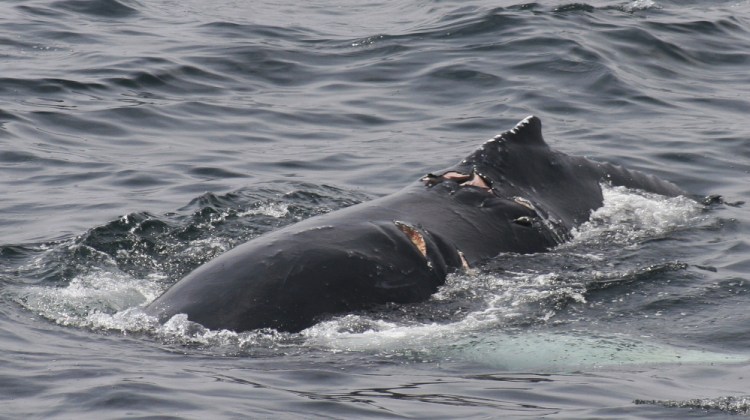A group of marine scientists says collisions of whales and boats off the New England coast may be more common than previously thought.
The scientists focused on the humpback whale population in the southern Gulf of Maine, a body of water off Massachusetts, New Hampshire and Maine. They found that almost 15 percent of the whales, which come to New England to feed every spring, had injuries or scarring consistent with at least one vessel strike.
The researchers, who published their findings in the March issue of the journal Marine Mammal Science, said the work shows that the occurrence of such strikes is most likely underestimated. They also said their own figure is likely low because it does not account for whales that are killed in ship strikes.
“Vessel strikes are a significant risk to both whales and to boaters,” said Alex Hill, the lead author of the study, who is a scientist with the conservation group Whale and Dolphin Conservation in Plymouth, Massachusetts. “Long-term studies can help us figure out if our outreach programs to boaters are effective, what kind of management actions are needed and help to assess the health of the population.”
Other scientists have also studied whether ship strikes have the ability to negatively affect whale populations, and the subject is a source of some debate.

While researchers are not sure how much such collisions affect whales, they are suggesting that marine managers develop strategies to minimize whale strikes.
A 2014 study of 171 blue whales in the eastern North Pacific that appeared in PLOS ONE stated that modifications to shipping lanes could “reduce the likelihood of collisions with vessels.” But a study that appeared in Marine Mammal Science that same year said mitigating ship strikes would have a minimal impact on the blue whales.
Off Alaska, 25 of 108 reported whale collisions that occurred between 1978 and 2011 resulted in the animal’s death, according to a 2012 report in the Journal of Marine Biology.
For the Gulf of Maine study, the authors reviewed more than 200,000 photos of 624 individual humpback whales over a nine-year period to evaluate them for injuries and trauma, the conservation group said. The group is recommending that marine managers develop a strategy for vessels that transit near whales to minimize collisions.
Dave Wiley, a research coordinator for Stellwagen Bank National Marine Sanctuary, said the paper could indeed inform regulations for federal managers. Wiley, who was not involved in the study, said it was “troublesome” to see the rate of strikes so high.
Scott Kraus, chief scientist for marine mammals at the New England Aquarium, was slightly more skeptical. Kraus, who also was not involved in the study, said the level of ship strikes could be overestimated in the paper because of the way the authors interpret scars and markings on humpback whales. However, Kraus said the findings are still valid.
“There are a lot of whales getting hit by small vessels, and there may very well need to be some management actions around high-density whale areas,” he said.
Send questions/comments to the editors.



Success. Please wait for the page to reload. If the page does not reload within 5 seconds, please refresh the page.
Enter your email and password to access comments.
Hi, to comment on stories you must . This profile is in addition to your subscription and website login.
Already have a commenting profile? .
Invalid username/password.
Please check your email to confirm and complete your registration.
Only subscribers are eligible to post comments. Please subscribe or login first for digital access. Here’s why.
Use the form below to reset your password. When you've submitted your account email, we will send an email with a reset code.